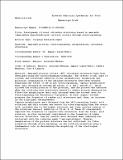Por favor, use este identificador para citar o enlazar a este item:
http://hdl.handle.net/10261/111067COMPARTIR / EXPORTAR:
 SHARE SHARE
 CORE
BASE CORE
BASE
|
|
| Visualizar otros formatos: MARC | Dublin Core | RDF | ORE | MODS | METS | DIDL | DATACITE | |

| Título: | Development of novel ultrathin structures based in amaranth (Amaranthus hypochondriacus) protein isolate through electrospinning |
Autor: | Aceituno Medina, Marysol; López-Rubio, Amparo CSIC ORCID ; Mendoza, Sandra; Lagarón Cabello, José María CSIC ORCID | Palabras clave: | Ultrathin structures Encapsulation Amaranth protein Electrospinning |
Fecha de publicación: | 2013 | Editor: | Elsevier | Citación: | Food Hydrocolloids 31: 289-298 (2013) | Resumen: | Amaranth protein isolate (API) ultrathin structures have been developed using the electrospinning technique. The effects of pH, type of solvent and surfactant addition on the spinnability, morphology and molecular organization of the obtained structures have been studied. Regarding the effect of pH on API electrospinning, capsule morphologies were only obtained at extreme pH values (i.e. pH 2 and pH 12), which allowed the solubilisation of the proteins, and the process was favoured when the solutions were previously heated to induce protein denaturation. Fibre-like morphologies were only obtained when the solvent used for electrospinning was hexafluoro-2-propanol, as this organic solvent promotes the formation of random coil structures and, thus, an increase in the biopolymer entanglements.Capsule morphologies were obtained from the API-containing formic acid solutions and this solvent was better for electrospraying than the acetic acid, probably due to the higher viscosity and lower surface tension of the solutions thereof. Addition of 20 wt.% of Tween 80 considerably improved the formation of capsule-like structures from the formic acid solution, as this surfactant contributed to the formation of alpha helical structures. Similar results were obtained when combining the surfactant with the reducing agent 2-mercaptoethanol. However, denaturation of the protein structure was not sufficient for fibre formation through electrospinning, as the solution properties play a fundamental role in determining the morphology of the electrospun structures. © 2012 Elsevier Ltd. | URI: | http://hdl.handle.net/10261/111067 | DOI: | 10.1016/j.foodhyd.2012.11.009 | Identificadores: | doi: 10.1016/j.foodhyd.2012.11.009 issn: 0268-005X |
| Aparece en las colecciones: | (IATA) Artículos |
Ficheros en este ítem:
| Fichero | Descripción | Tamaño | Formato | |
|---|---|---|---|---|
| Food Hydrocolloids-2013-Aceituno.pdf | 970,53 kB | Adobe PDF |  Visualizar/Abrir |
CORE Recommender
SCOPUSTM
Citations
84
checked on 16-abr-2024
WEB OF SCIENCETM
Citations
68
checked on 28-feb-2024
Page view(s)
366
checked on 18-abr-2024
Download(s)
625
checked on 18-abr-2024
Google ScholarTM
Check
Altmetric
Altmetric
NOTA: Los ítems de Digital.CSIC están protegidos por copyright, con todos los derechos reservados, a menos que se indique lo contrario.
